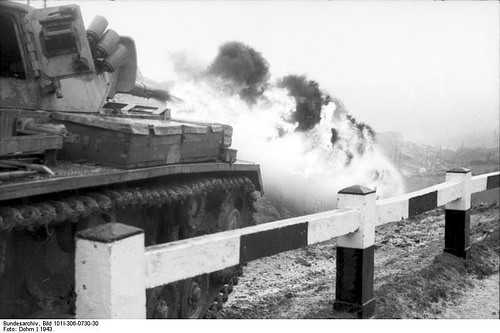
| Year | February 1943 |
| Vehicle Type | Medium Flame-Thrower Tank |
| Origin & Designer | Germany/Wegmann |
| Numbers Produced | 100 |
| Crew | 3 (Commander/Gunner, Radio Operator & Driver) |
| Main Armament | 1 x 14mm Flammenwerfer |
| Main Armament | [@sponson_traverse] |
| Elevation | -8° to +20° |
| Turret Traverse | 360° |
| Gun Traverse | [@gun_traverse] |
| Gun Mount | [@gun_mounts] |
| Maximum Range | [@maximum_range] |
| Armour Penetration | [@armour_penetration] |
| Gun Sight | [@gun_sight] |
| Secondary Armament | 2 x 7.92mm MG34s (Coaxial & Bow) |
| Smoke Discharger | [@smoke_discharger] |
| Ammunition Carried | 1000 Litres + 3.750 x 7.92mm |
| Height | 2.50m |
| Width | 2.95m |
| Length | 2.41m |
| Combat Weight | 23.000 kg |
| Ground Clearance | 0.39m |
| Fording Depth | 0.80m |
| Trench Crossing | 2.0m |
| Obstacle Clearance | 0.60m |
| Climbing Ability | 30° |
| Radio | FuG-5 |
| Armour | Hull Front: 50mm Hull Sides: 30mm Hull Rear: 50mm Hull Top: 18mm Hull Bottom: 16mm Gun Mantle: 50mm Turret Front: 57mm Turret Sides: 30mm Turret Rear: 30mm Turret Top: 10mm |
| Engine | Maybach HL120TM (Petrol) |
| Transmission | 6 Forward & 1 Reverse |
| Maximum Road Range | 145 km |
| Maximum Cross Country Range | 85 km |
| Maximum Water Range | [@maximum_water_range] |
| Maximum Road Speed | 40 kph |
| Maximum Cross Country Speed | 19 kph |
| Maximum Water Speed | [@maximum_water_speed] |
| Variants | [@variants] |
| Notes | In early 1943 the panzer Mk. III was chosen to mount a flame-thrower, this came about during the battle of Stalingrad and the lack of a flame-throwing tank was evident. The ausf M was chosen and they had their 50mm guns removed and replaced with a single flame-thrower. The frontal armour was also increased by 30mm to provide protection. The first vehicles arrived too late to be used at Stalingrad and they first saw large scale action during the battle of Kursk. |